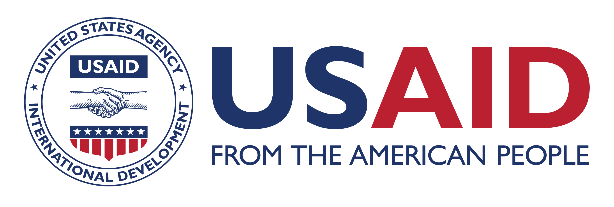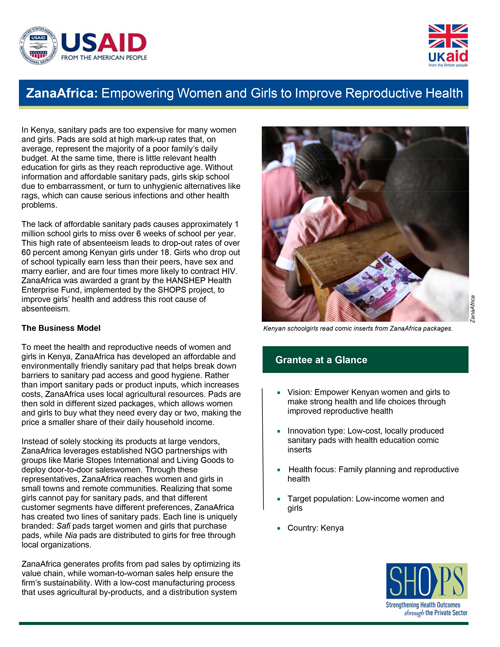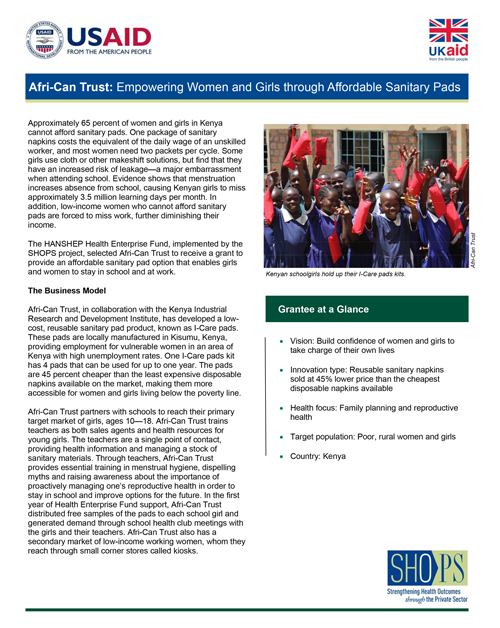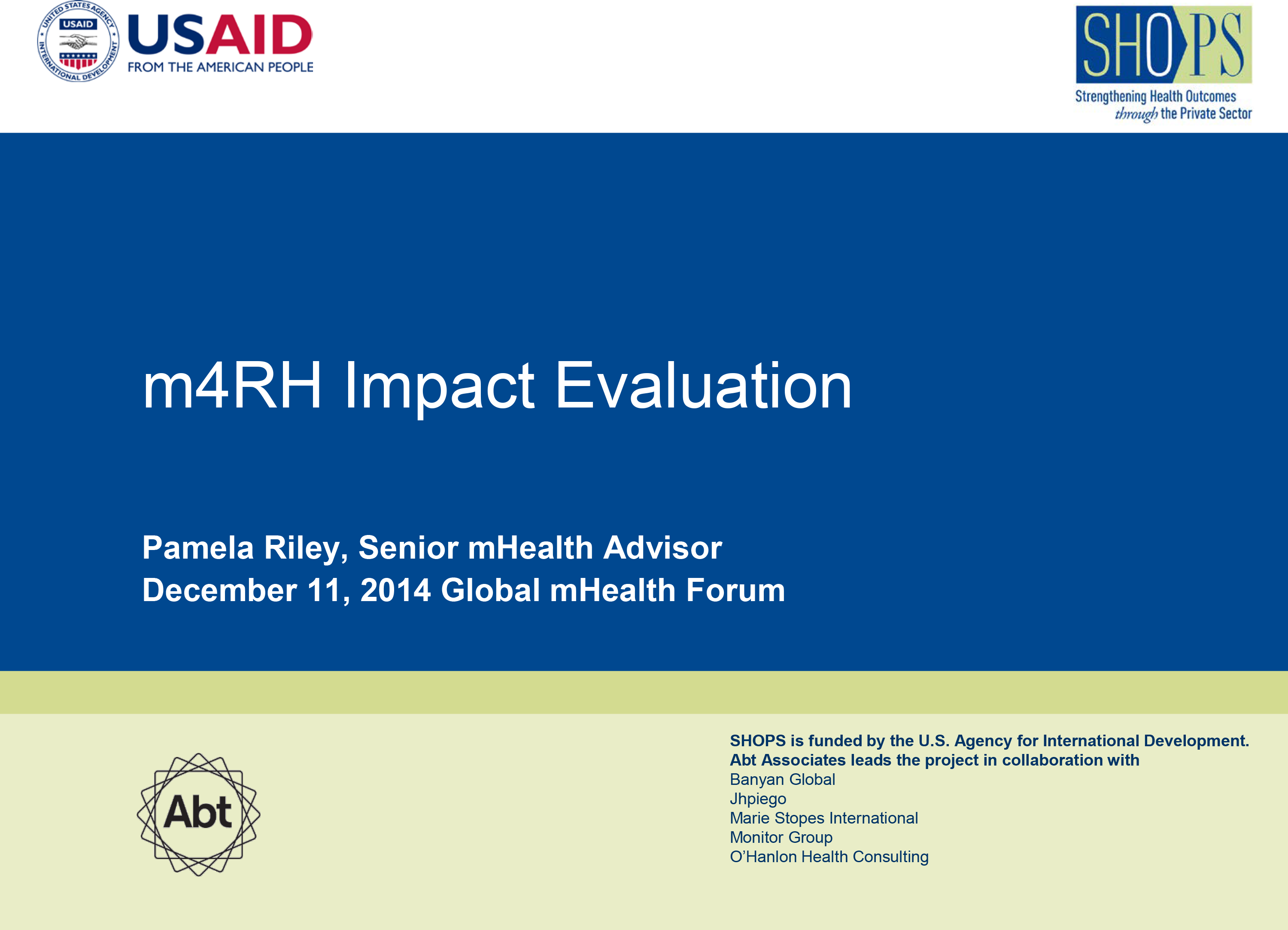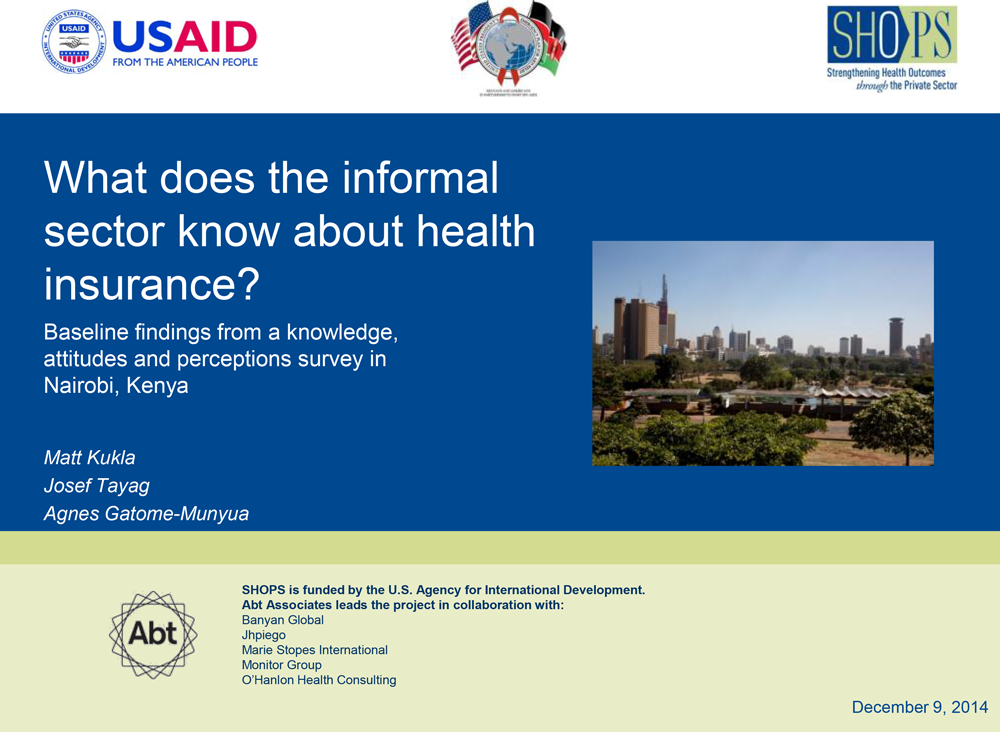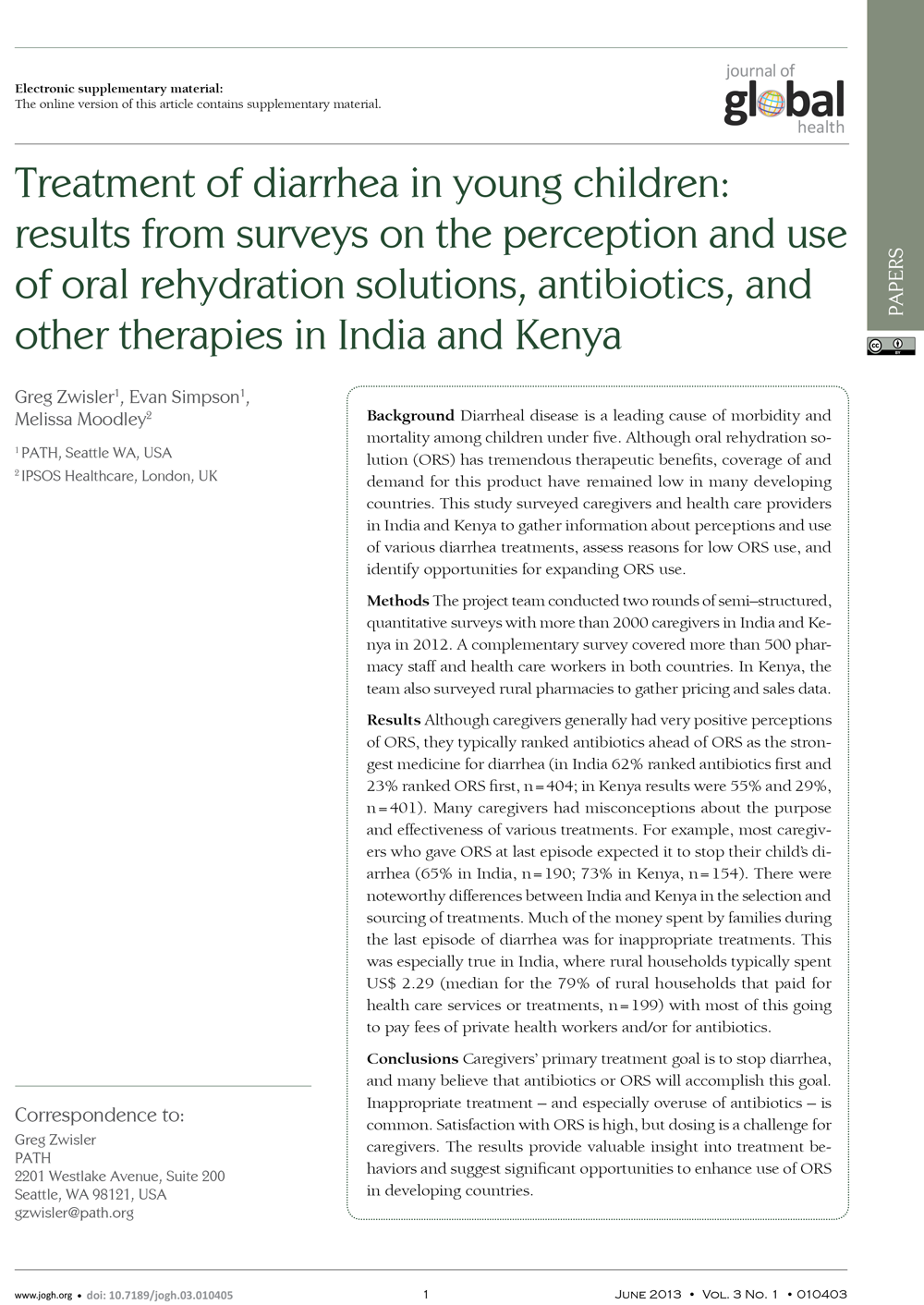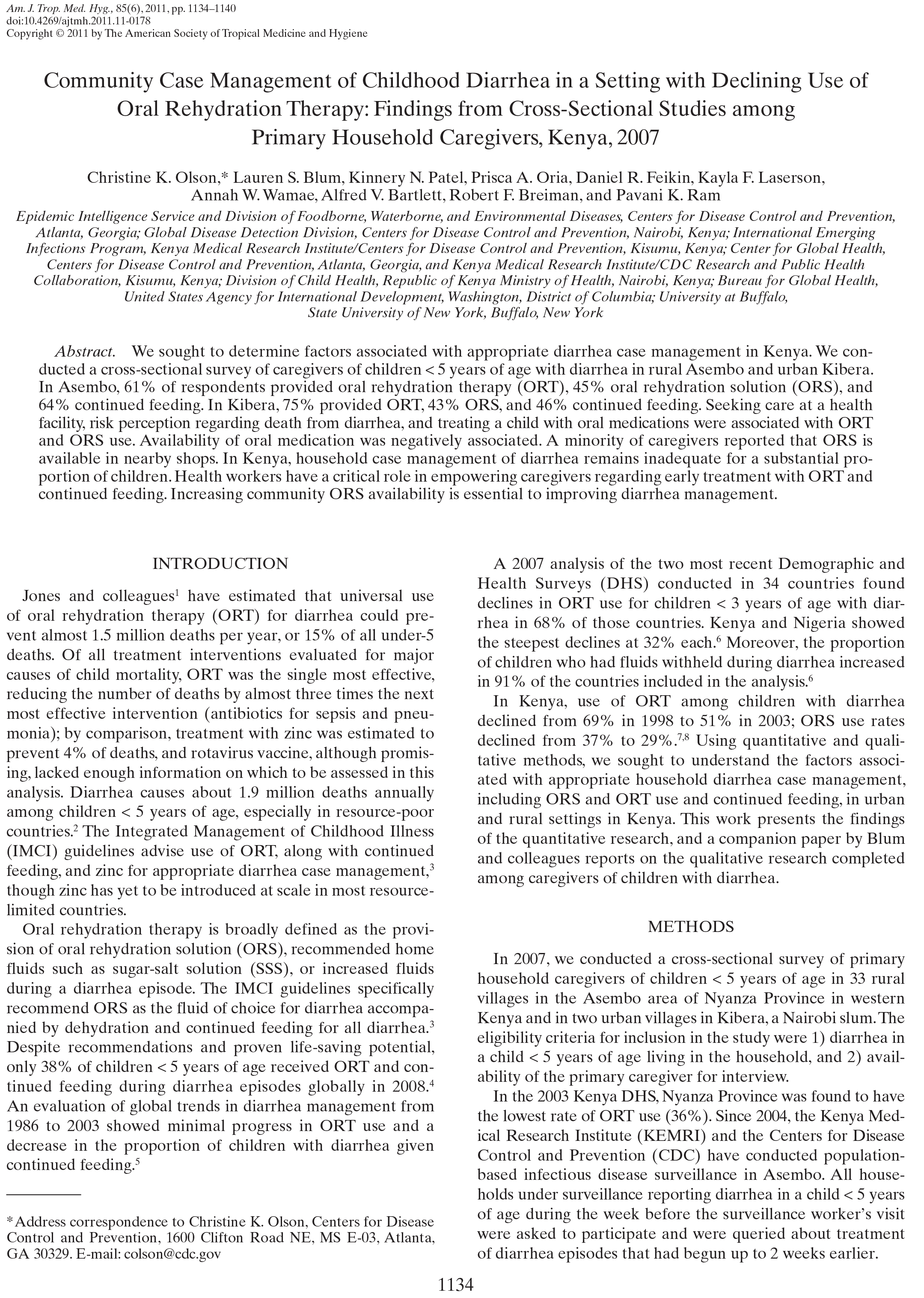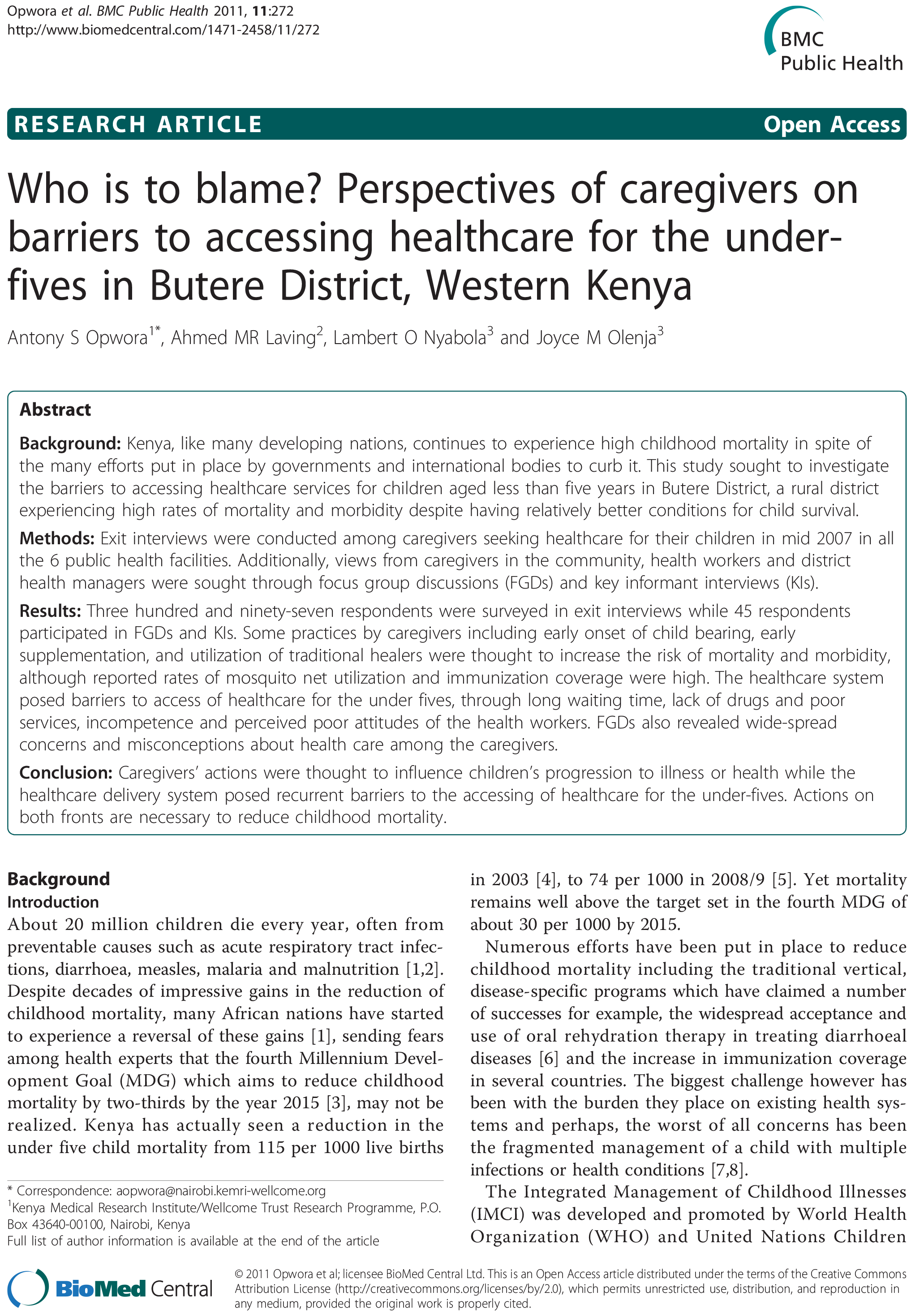
Resource Library
ZanaAfrica: Empowering Women and Girls to Improve Reproductive Health
This profile of ZanaAfrica, a HANSHEP Health Enterprise Fund awardee, provides an overview of the grantee. It includes a description of the challenge posed by expensive sanitary pads in Kenya, the business model ZanaAfrica is using to address it, the support the Health Enterprise Fund is providing, and the impact of the grantee.
Resource Type : Brief
Country : Kenya
Year : 2015-03-10T00:00:00
Language : English
Project : SHOPS

Resource Library
Afri-Can Trust: Empowering Women and Girls through Affordable Sanitary Pads
This profile of Afri-Can Trust, a HANSHEP Health Enterprise Fund awardee, provides an overview of the grantee. It includes a description of the challenge women and girls face with sanitary pads in Kenya, the business model Afri-Can Trust is using to address it, the support the Health Enterprise Fund is providing, and the impact of the grantee.
Resource Type : Brief
Country : Kenya
Year : 2015-02-11T00:00:00
Language : English
Project : SHOPS

Resource Library
m4RH Impact Evaluation
This presentation describes a SHOPS evaluation of the impact of accessing mobiles for reproductive health (m4RH) on family planning methods and the use of contraception. It was presented at the Global mHealth Forum in National Harbor, Maryland on December 11, 2014.
Resource Type : Presentation
Country : Kenya
Year : 2014-12-12T00:00:00
Language : English
Project : SHOPS

Resource Library
What Does the Informal Sector Know about Health Insurance?
SHOPS is implementing a behavior change communication campaign in Nairobi, Kenya, targeted at informal sector workers earning $5 - $15 per day. The objective is to change their attitudes and perceptions towards health insurance which can improve financial access to HIV care and other needed health services. This formative research was gathered through focus group discussions and a household survey of informal sector workers earning $5 - $15 per day. The focus groups and the survey collected information on the target population’s knowledge of basic health insurance concepts, attitudes toward insurance companies and existing health insurance products, household priorities, and health seeking practices. This evidence is informing the behavior change campaign to make sure that is tailored to appeal to the motivations of informal sector workers, especially those who are likely to need HIV services. The presentation was made by Agnes Gatome-Munyua at a meeting with members of the Association of Kenyan Insurers in November 2014.
Resource Type : Presentation
Country : Kenya
Year : 2014-11-17T00:00:00
Language : English
Project : SHOPS

Resource Library
Treatment of diarrhea in young children: results from surveys on the perception and use of oral rehydration solutions, antibiotics, and other therapies in India and Kenya
The objective of this study was to investigate the clinical characteristics of children who died from diarrhea in low- and middle-income countries, such as the duration of diarrhoea, comorbid conditions, care-seeking behavior and oral rehydration therapy use. The study included verbal autopsy data on children who died from diarrhea between 2000 and 2012 at seven sites in Bangladesh, Ethiopia, Ghana, India, Pakistan, Uganda and the United Republic of Tanzania, respectively. Data came from demographic surveillance sites, randomized trials and an extended Demographic and Health Survey. The type of diarrhea was classified as acute watery, acute bloody or persistent and risk factors were identified. Deaths in children aged 1 to 11 months and 1 to 4 years were analyzed separately. Findings revealed that the proportion of childhood deaths due to diarrhea varied considerably across the seven sites from less than 3% to 30%. Among children aged 1–4 years, acute watery diarrhea accounted for 31–69% of diarrheal deaths, acute bloody diarrhea for 12–28%, and persistent diarrhea for 12–56%. Among infants aged 1–11 months, persistent diarrhea accounted for over 30% of diarrheal deaths in Ethiopia, India, Pakistan, Uganda and the United Republic of Tanzania. At most sites, more than 40% of children who died from persistent diarrhea were malnourished. Persistent diarrhea remains an important cause of diarrheal death in young children in low- and middle-income countries. Research is needed on the public health burden of persistent diarrhea and current treatment practices to understand why children are still dying from the condition.
Resource Type : Brief
Country : India, Kenya
Year : 2013-06-01T00:00:00
Language : English
Project : SHOPS

Resource Library
Community Case Management of Childhood Diarrhea in a Setting with Declining Use of Oral Rehydration Therapy: Findings from Cross-Sectional Studies among Primary Household Caregivers, Kenya, 2007
We sought to determine factors associated with appropriate diarrhea case management in Kenya. We conducted a cross-sectional survey of caregivers of children < 5 years of age with diarrhea in rural Asembo and urban Kibera. In Asembo, 61% of respondents provided oral rehydration therapy (ORT), 45% oral rehydration solution (ORS), and 64% continued feeding. In Kibera, 75% provided ORT, 43% ORS, and 46% continued feeding. Seeking care at a health facility, risk perception regarding death from diarrhea, and treating a child with oral medications were associated with ORT and ORS use. Availability of oral medication was negatively associated. A minority of caregivers reported that ORS is available in nearby shops. In Kenya, household case management of diarrhea remains inadequate for a substantial proportion of children. Health workers have a critical role in empowering caregivers regarding early treatment with ORT and continued feeding. Increasing community ORS availability is essential to improving diarrhea management.
Resource Type : Brief
Country : Kenya
Year : 2011-06-01T00:00:00
Language : English
Project : SHOPS

Resource Library
Health Seeking Behaviour of Mothers of Under-Five-Year-Old Children in the Slum Communities of Nairobi, Kenya
Prompt and appropriate health seeking is critical in the management of childhood illnesses. This paper examines the health seeking behaviour in under-five child morbidity. It explores in detail actions taken by 28 mothers when their children become sick. Sixty-two in-depth interviews with mothers were conducted from four study communities. The mothers were identified from a demographic surveillance system. The interviews were tape-recorded, transcribed and thematically analysed. The study shows that mothers classify childhood illnesses into four main categories: (1) not serious—coughs, colds, diarrhoea; (2) serious but not life-threatening—malaria; (3) sudden and serious—pneumonia; and (4) chronic and therefore not requiring immediate action—malnutrition, tuberculosis, chronic coughs. This classification is reflected in the actions taken and time it takes to act. Shops are used as the first source of healthcare, and when the care moves out of the home, private health facilities are used more compared to public health facilities, while even fewer mothers consult traditional healers. Consequently we conclude that there is a need to train mothers to recognize potentially life-threatening conditions and to seek appropriate treatment promptly. Drug vendors should be involved in intervention programs because they reach many mothers at the critical time of health seeking.
Resource Type :
Country : Kenya
Year : 2006-01-01T00:00:00
Language : English
Project : SHOPS

Resource Library
Community understanding of pneumonia in Kenya
Effective management of pneumonia demands active participation by the caretaker to facilitate early seeking of appropriate health care and adequate compliance to home care messages. This would only be possible if the caretakers’ perception of pneumonia is appropriate. This study aims to determine community’s perception of childhood pneumonia in a suburb of Nairobi.
The objective of this study is to determine community perception of childhood pneumonia through a cross sectional study utilizing qualitative ethnographic methodology. The participants included six key informants for in-depth interview and eight groups for focus group discussions from the study community.
Pneumonia was perceived to be the most serious childhood illness. There was a great deal of diversity of Kikuyu phrases for chest-in drawing. There was no term for rapid breathing. Chest in-drawing, fever, difficult in breathing, startling at night and convulsions were perceived as features of pneumonia. Chest in-drawing, fever and convulsions were indicative of severe disease.
It was concluded that the caretakers perceived severe pneumonia as outlined in the IMCI guidelines. Non-severe pneumonia was not perceived for what it should be. Inappropriate knowledge on causes of pneumonia and signs of non severe pneumonia are likely to interfere with compliance with home care messages.
Resource Type :
Country : Kenya
Year : 2008-06-02T00:00:00
Language : English
Project : SHOPS

Resource Library
Mother's health seeking behaviour during child illness in a rural western Kenya community
In most developing countries, the health of the children is strongly dependant on maternal healthcare behaviour. The study describes the prevalence of illness among preschool children in a rural sugarcane growing community and the mother’s health seeking behavior.
The objectives of the study were to document the presence of illness among preschool children at household level in a rural community in Western Kenya and also determine the mother’s health seeking behavior during the course of these illnesses.
This was an observational cross-sectional community survey using interview schedules, key informants and focus group discussions and Makunga Rural Health Center in Kakamega District western Kenya. Descriptive statistics were used in data analysis.
Fifty two percent of the children had had at least one illness a week prior to the survey. Fever was the most commonly reported symptom with 48% of the cases. A third (32.4%) of the mothers purchased and administered drugs to their sick children without seeking medical attention. The most commonly reported reasons for this behavior were: the government health facilities were at a distance, the services are poor and inability to afford services at the private hospitals and clinics.
Intervention programmes focusing on diversification of income sources, maternal education and community based mobile clinics are likely to contribute towards improved health of children in this and any other rural sugarcane growing community.
Resource Type :
Country : Kenya
Year : 2005-12-04T00:00:00
Language : English
Project : SHOPS

Resource Library
Who is to blame? Perspectives of caregivers on barriers to accessing healthcare for the under-fives in Butere District, Western Kenya
Kenya, like many developing nations, continues to experience high childhood mortality in spite of the many efforts put in place by governments and international bodies to curb it. This study sought to investigate the barriers to accessing healthcare services for children aged less than five years in Butere District, a rural district experiencing high rates of mortality and morbidity despite having relatively better conditions for child survival.
Exit interviews were conducted among caregivers seeking healthcare for their children in mid 2007 in all the 6 public health facilities. Additionally, views from caregivers in the community, health workers and district health managers were sought through focus group discussions (FGDs) and key informant interviews (KIs).
Three hundred and ninety-seven respondents were surveyed in exit interviews while 45 respondents
participated in FGDs and KIs. Some practices by caregivers including early onset of child bearing, early supplementation, and utilization of traditional healers were thought to increase the risk of mortality and morbidity, although reported rates of mosquito net utilization and immunization coverage were high. The healthcare system posed barriers to access of healthcare for the under fives, through long waiting time, lack of drugs and poor services, incompetence and perceived poor attitudes of the health workers. FGDs also revealed wide-spread concerns and misconceptions about health care among the caregivers.
Caregivers’ actions were thought to influence children’s progression to illness or health while the healthcare delivery system posed recurrent barriers to the accessing of healthcare for the under-fives. Actions on both fronts are necessary to reduce childhood mortality.
Resource Type : Brief
Country : Kenya
Year : 2011-11-01T00:00:00
Language : English
Project : SHOPS
Pagination
- Previous page
- Page 7
- Next page

